-
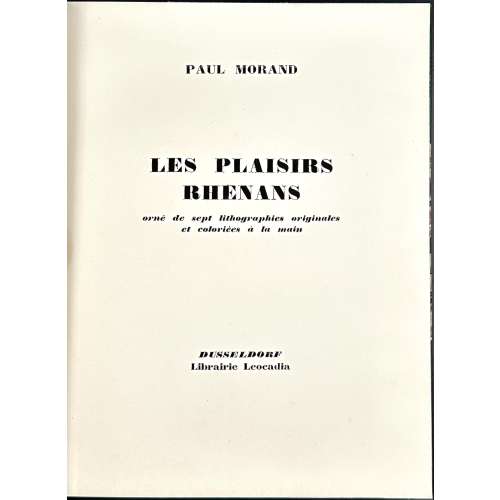 NEWHardcover, 255 x 200 mm, ¾ green morocco over marbled boards, gilt lettering to spine with raised bands, grey laid paper endpapers, Serge Golifman’s bookplate pasted to verso, 3 ffl, orig. wrappers, incl spine, preserved; collated: 2 blanks, h.t., t.p., 14 leaves of text; faux t.p. Éloge de la marquise de Beausemblant, 6 leaves of text, colophon (limitation), 2 blanks, 3 ffl, unpaginated, plus 7 leaves of plates, incl. frontispiece. Publisher's wrappers 250 x 190 mm. Title-page (red and black): PAUL MORAND | LES PLAISIRS | RHENANS | orné de sept lithographies originales | et coloriées à la main | DUSSELDORF | Librairie Leocadia || The front wrapper is the same, in black only. Limitation: Cette édition, imprimée pour une Société de Bibliophiles, a été tirée à 107 exemplaires hors commerce, savoir: exemplaires sur vieux japon, numérotés de 1 à 7, et 100 exemplaires sur vélin d'Arches, numérotés de 8 à 107. Les lithographies ont été tirées sur presse à bras et coloriées à la main. Les pierres ont été poncées après tirage. Exemplaire N° 81. [The edition was printed for a bibliophile society in 107 non-commercial copies: 7 copies on “vieux Japon” paper, numbered from 1 to 7, and 100 copies on “Arches Vellum”, numbered from 8 to 107, of which this is copy № 81]. An unauthorized (pirated) edition of two short stories by Paul Morand, initially published in “L’Europe galante” by Éditions Grasset in 1925: Les plaisirs rhénans and Éloge de la marquise de Beausemblant; illustrated with 7 lithographs coloured with crayons after Gaston-Louis Roux, printed by Mme Duchatel; the stones were then destroyed (sanded). According to Pia: « Pour le principe, semble-t-il, Bernard Grasset à qui aucune autorisation d’éditer ainsi ces deux nouvelles n'avait été demandée, déposa une plainte contre X... en contrefaçon. L'enquête judiciaire, si enquête il y eut, n’aboutit pas. Le tirage de l’édition « pirate » avait été si restreint que tous les exemplaires en avaient été vendus sitôt parus. Le coupable, en l’occurrence René Bonnel, ne fut pas inquiété ». Dutel attests: « Un des personnages, subissant une agréable fellation, représenté sur l'une des lithographies, ressemble fort à Paul Morand qui en avait pris ombrage! » Comment by the seller: L’ouvrage est d’autant plus rare que Morand lui-même, mécontent d’une des gravures qui le représente en position intéressante, fit détruire une partie des exemplaires. Resume: While Bernard Grasset opposed the pirated edition on copyright infringement grounds, Paul Morand was enraged by his resemblance to the depicted character; the latter destroyed as many copies of the edition as he could, so only a few still exist. The print run of the "pirate" edition was so limited that all the copies were sold as soon as they were published. Catalogue Raisonné: Dutel III № 2215 (p. 321) ; Pia : № 1056; Nordmann (I) № 281. Contributors: Paul Morand (French, 1888 – 1976) – author Gaston-Louis Roux (French, 1904 – 1988) – artist René Bonnel (French, 18841 – 1975) – publisher Bernard Grasset (French, 1881 – 1955) – publisher
NEWHardcover, 255 x 200 mm, ¾ green morocco over marbled boards, gilt lettering to spine with raised bands, grey laid paper endpapers, Serge Golifman’s bookplate pasted to verso, 3 ffl, orig. wrappers, incl spine, preserved; collated: 2 blanks, h.t., t.p., 14 leaves of text; faux t.p. Éloge de la marquise de Beausemblant, 6 leaves of text, colophon (limitation), 2 blanks, 3 ffl, unpaginated, plus 7 leaves of plates, incl. frontispiece. Publisher's wrappers 250 x 190 mm. Title-page (red and black): PAUL MORAND | LES PLAISIRS | RHENANS | orné de sept lithographies originales | et coloriées à la main | DUSSELDORF | Librairie Leocadia || The front wrapper is the same, in black only. Limitation: Cette édition, imprimée pour une Société de Bibliophiles, a été tirée à 107 exemplaires hors commerce, savoir: exemplaires sur vieux japon, numérotés de 1 à 7, et 100 exemplaires sur vélin d'Arches, numérotés de 8 à 107. Les lithographies ont été tirées sur presse à bras et coloriées à la main. Les pierres ont été poncées après tirage. Exemplaire N° 81. [The edition was printed for a bibliophile society in 107 non-commercial copies: 7 copies on “vieux Japon” paper, numbered from 1 to 7, and 100 copies on “Arches Vellum”, numbered from 8 to 107, of which this is copy № 81]. An unauthorized (pirated) edition of two short stories by Paul Morand, initially published in “L’Europe galante” by Éditions Grasset in 1925: Les plaisirs rhénans and Éloge de la marquise de Beausemblant; illustrated with 7 lithographs coloured with crayons after Gaston-Louis Roux, printed by Mme Duchatel; the stones were then destroyed (sanded). According to Pia: « Pour le principe, semble-t-il, Bernard Grasset à qui aucune autorisation d’éditer ainsi ces deux nouvelles n'avait été demandée, déposa une plainte contre X... en contrefaçon. L'enquête judiciaire, si enquête il y eut, n’aboutit pas. Le tirage de l’édition « pirate » avait été si restreint que tous les exemplaires en avaient été vendus sitôt parus. Le coupable, en l’occurrence René Bonnel, ne fut pas inquiété ». Dutel attests: « Un des personnages, subissant une agréable fellation, représenté sur l'une des lithographies, ressemble fort à Paul Morand qui en avait pris ombrage! » Comment by the seller: L’ouvrage est d’autant plus rare que Morand lui-même, mécontent d’une des gravures qui le représente en position intéressante, fit détruire une partie des exemplaires. Resume: While Bernard Grasset opposed the pirated edition on copyright infringement grounds, Paul Morand was enraged by his resemblance to the depicted character; the latter destroyed as many copies of the edition as he could, so only a few still exist. The print run of the "pirate" edition was so limited that all the copies were sold as soon as they were published. Catalogue Raisonné: Dutel III № 2215 (p. 321) ; Pia : № 1056; Nordmann (I) № 281. Contributors: Paul Morand (French, 1888 – 1976) – author Gaston-Louis Roux (French, 1904 – 1988) – artist René Bonnel (French, 18841 – 1975) – publisher Bernard Grasset (French, 1881 – 1955) – publisher -
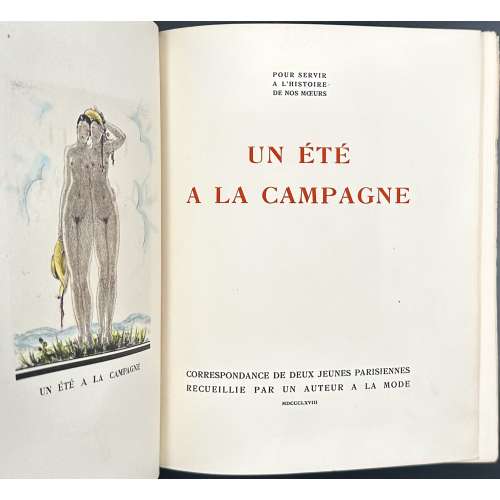 Softcover, 228 x 180 mm, tan French flapped wrappers with red lettering to front[1-4, owner’s glassine dustcover, top edge trimmed, printed on thick wove paper without a watermark; pp.: ffl [1-4 h.t., t.p.] 5-154 [2 blanks] colophon to back ffl recto, plus 12 plates with hand-coloured lithographs, extraneous to collation. Pencil and pigment drawing to h.t. signed “J. D’A” with gift manual inscription “A Monsieur et Madame Chalamel [sic] ce tardif mais sincère souvenir de sympathie”, signed “J et Y D’A.” Etching bookplate to front ffl recto: “EX LIBRIS PIERRE CHALLAMEL | JE FONCE DANS LE BROUILLARD”, signed “J A M” (Jean-Adrien Mercier). The signature J. D’A stands for Jean d’Angers, while Y D’A stands for Jean-Adrien’s wife Yvonne (1902—1999), nicknamed Zizi; they married in 1927. According to J.-P. Dutel, the stated illustrator of this edition, Jean d’Angers is indeed Jean-Adrien Mercier. The text belongs to Gustav Droz and, possibly, Auguste Poulet-Malassis. Limitation: the book was printed for subscribers in 30 copies on Japon Impériale paper (№№ 1-30) and 250 copies on vélin du Marais paper (№№ 31-280). This copy bears № 123 and was presented as a gift by the artist and his wife to Pierre Challamel. Title-page (red and black): POUR SERVIR | A L'HISTOIRE | DE NOS MŒURS | UN ÉTÉ | A LA CAMPAGNE | CORRESPONDANCE DE DEUX JEUNES PARISIENNES | RECUEILLIE PAR UN AUTEUR A LA MODE | MDCCCLXVIII || Catalogue raisonné: Dutel III № 2546; honesterotica. Provenance: Pierre Challamel (French, 20th century) Contributors: Gustave Droz (French, 1832 – 1895) – author (presumable). Auguste Poulet-Malassis (French, 1825 – 1878) – author (presumable). Jean-Adrien Mercier (French, 1899 – 1995) – artist. Micro photo of the lithography:
Softcover, 228 x 180 mm, tan French flapped wrappers with red lettering to front[1-4, owner’s glassine dustcover, top edge trimmed, printed on thick wove paper without a watermark; pp.: ffl [1-4 h.t., t.p.] 5-154 [2 blanks] colophon to back ffl recto, plus 12 plates with hand-coloured lithographs, extraneous to collation. Pencil and pigment drawing to h.t. signed “J. D’A” with gift manual inscription “A Monsieur et Madame Chalamel [sic] ce tardif mais sincère souvenir de sympathie”, signed “J et Y D’A.” Etching bookplate to front ffl recto: “EX LIBRIS PIERRE CHALLAMEL | JE FONCE DANS LE BROUILLARD”, signed “J A M” (Jean-Adrien Mercier). The signature J. D’A stands for Jean d’Angers, while Y D’A stands for Jean-Adrien’s wife Yvonne (1902—1999), nicknamed Zizi; they married in 1927. According to J.-P. Dutel, the stated illustrator of this edition, Jean d’Angers is indeed Jean-Adrien Mercier. The text belongs to Gustav Droz and, possibly, Auguste Poulet-Malassis. Limitation: the book was printed for subscribers in 30 copies on Japon Impériale paper (№№ 1-30) and 250 copies on vélin du Marais paper (№№ 31-280). This copy bears № 123 and was presented as a gift by the artist and his wife to Pierre Challamel. Title-page (red and black): POUR SERVIR | A L'HISTOIRE | DE NOS MŒURS | UN ÉTÉ | A LA CAMPAGNE | CORRESPONDANCE DE DEUX JEUNES PARISIENNES | RECUEILLIE PAR UN AUTEUR A LA MODE | MDCCCLXVIII || Catalogue raisonné: Dutel III № 2546; honesterotica. Provenance: Pierre Challamel (French, 20th century) Contributors: Gustave Droz (French, 1832 – 1895) – author (presumable). Auguste Poulet-Malassis (French, 1825 – 1878) – author (presumable). Jean-Adrien Mercier (French, 1899 – 1995) – artist. Micro photo of the lithography:
Micro photo of the original drawing: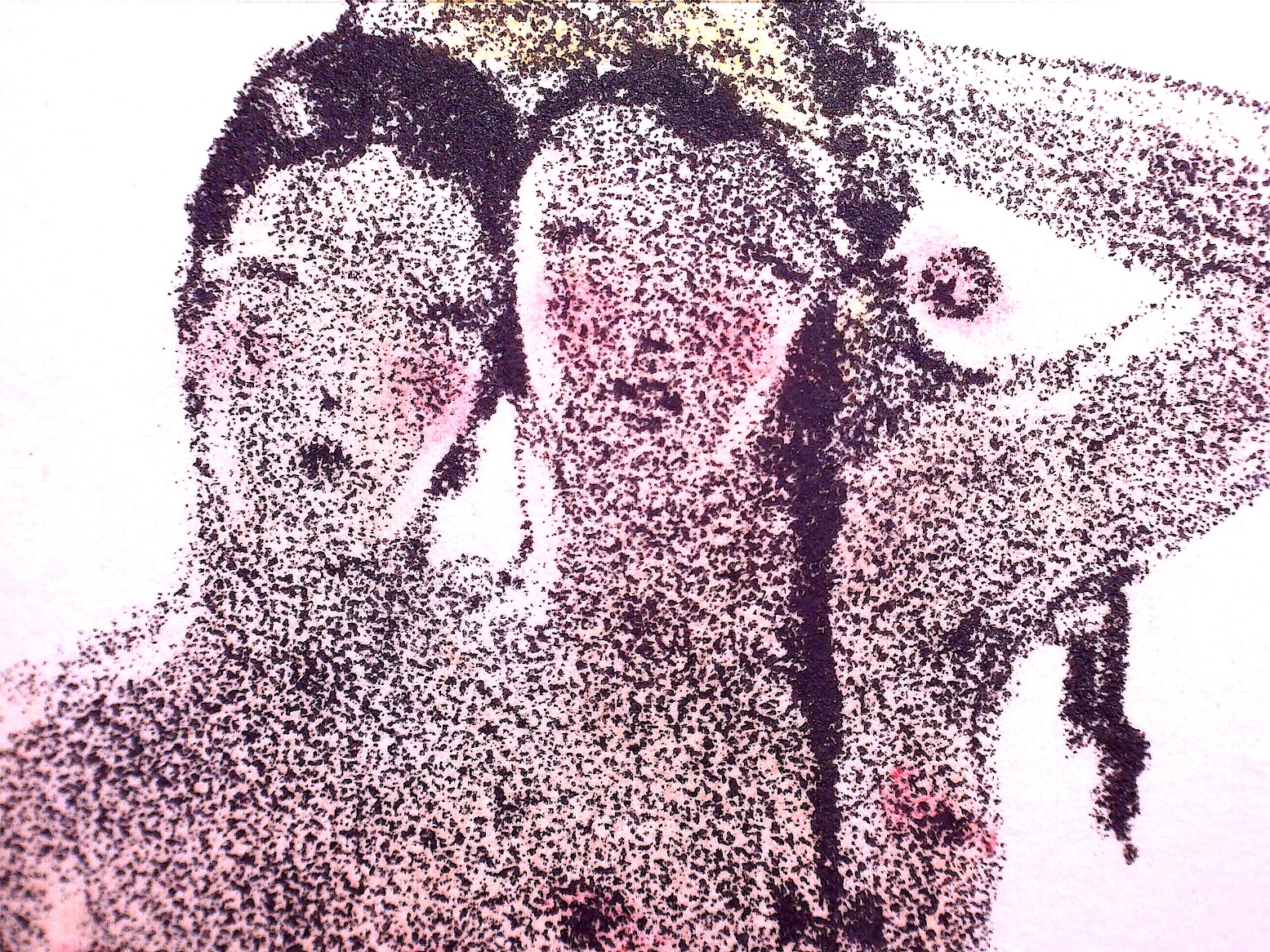
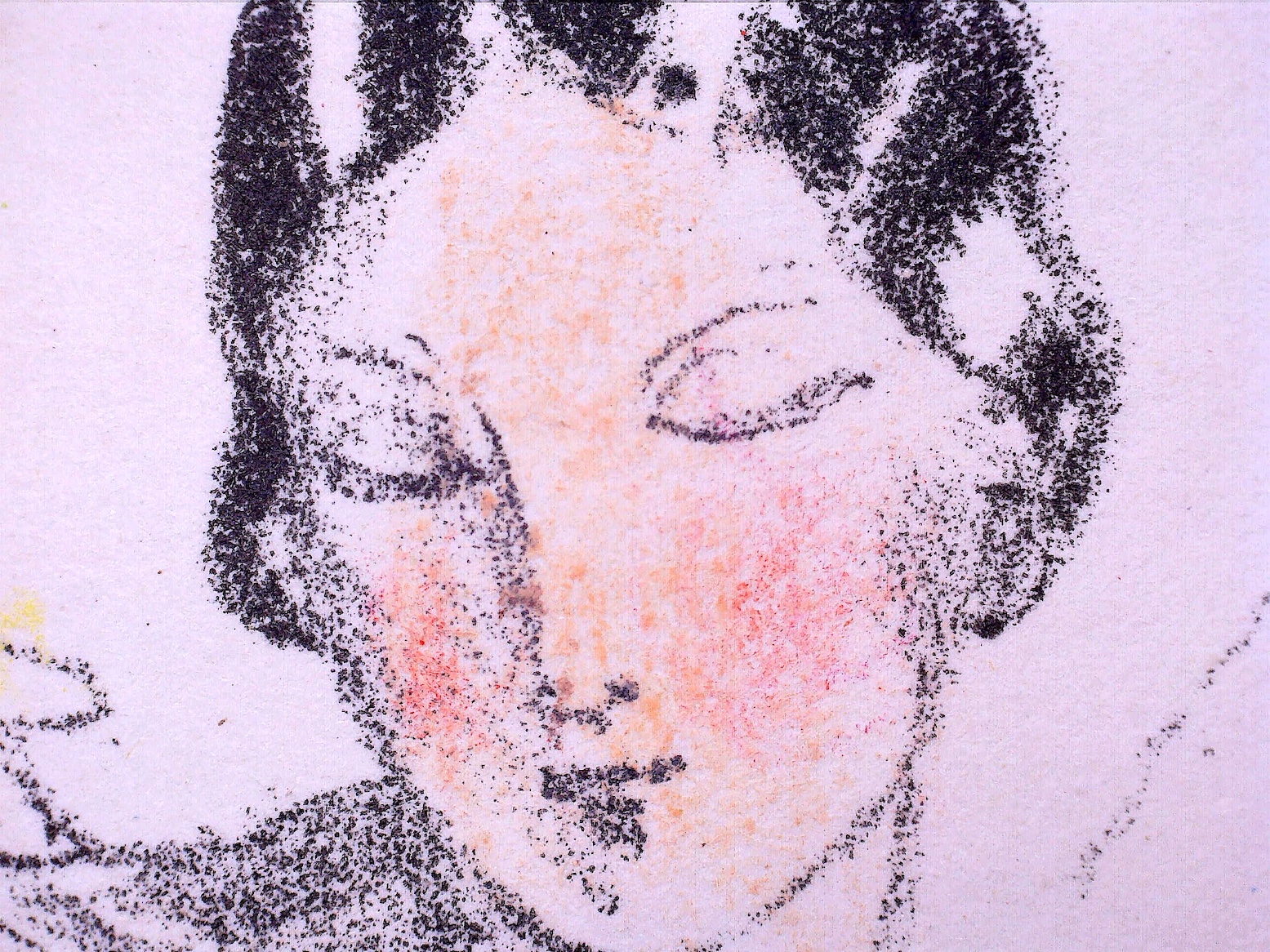
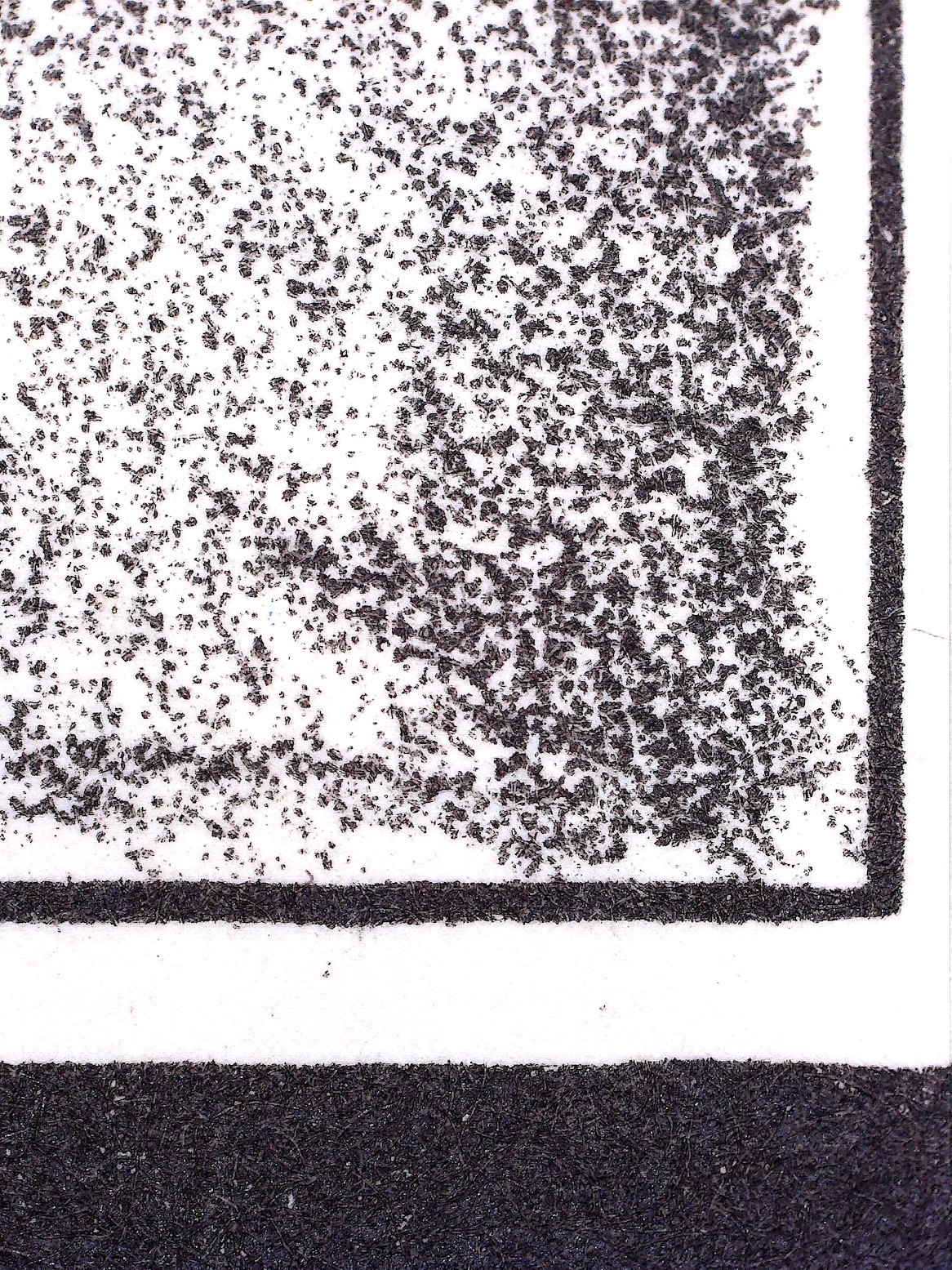
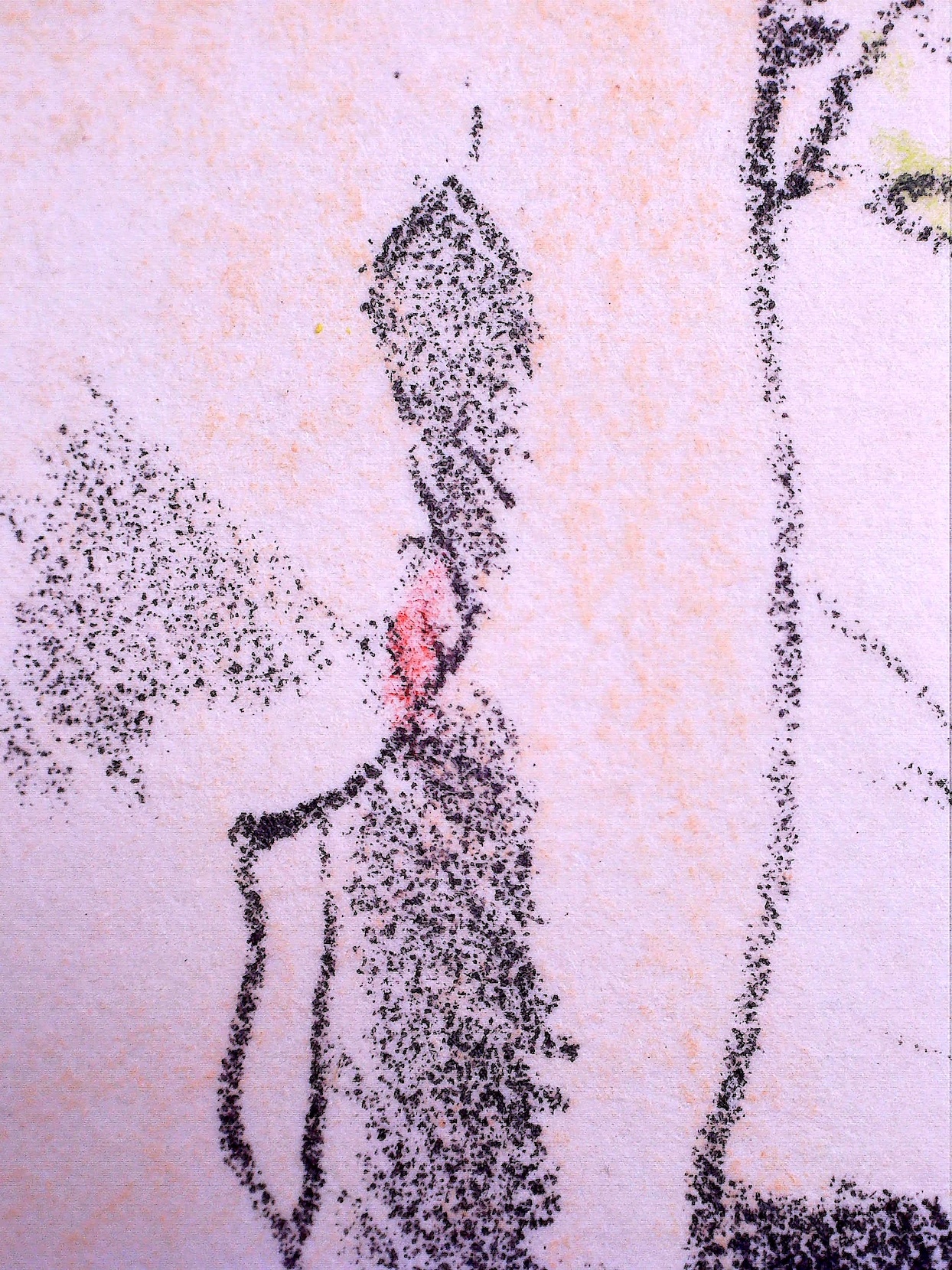
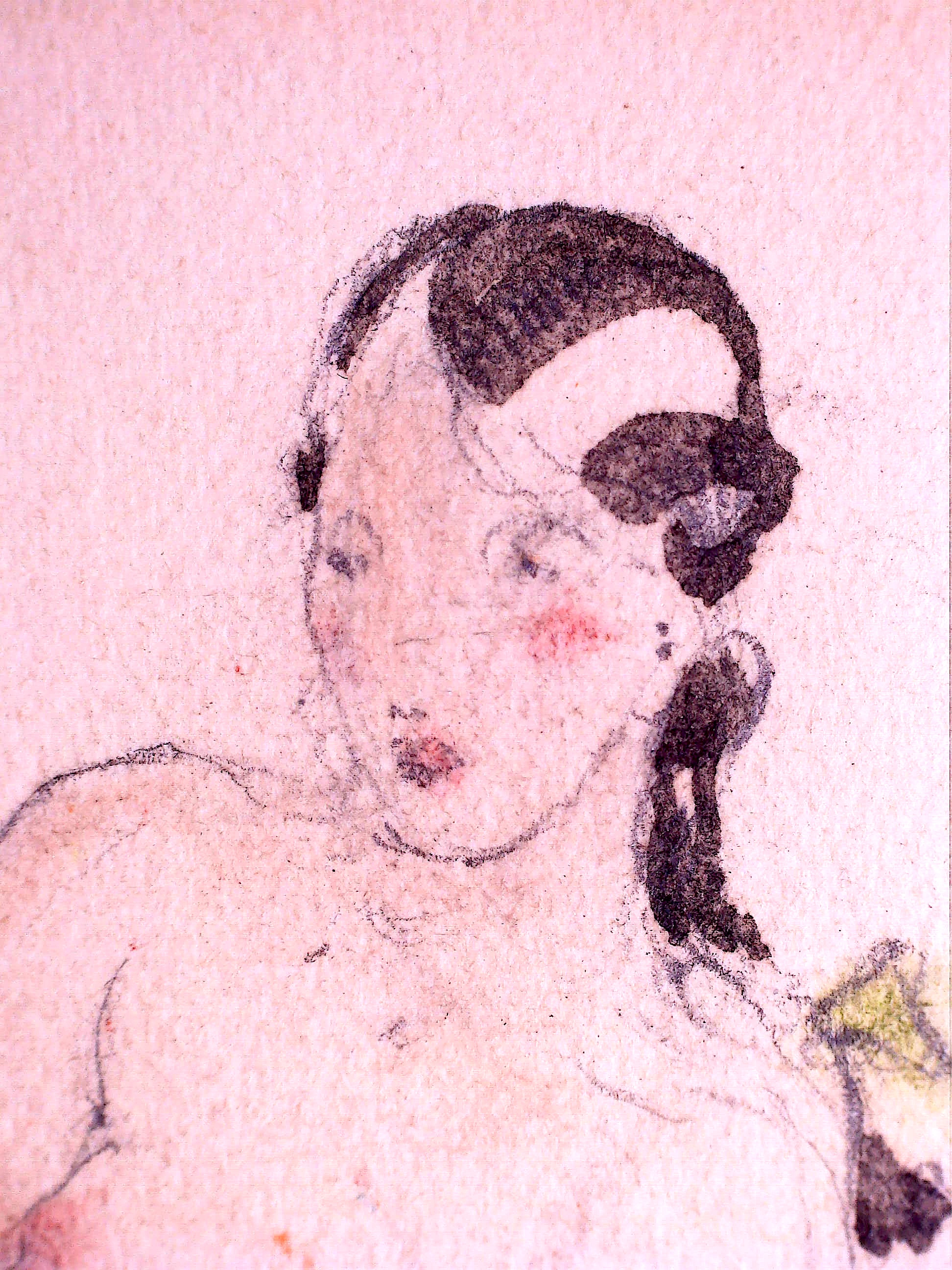
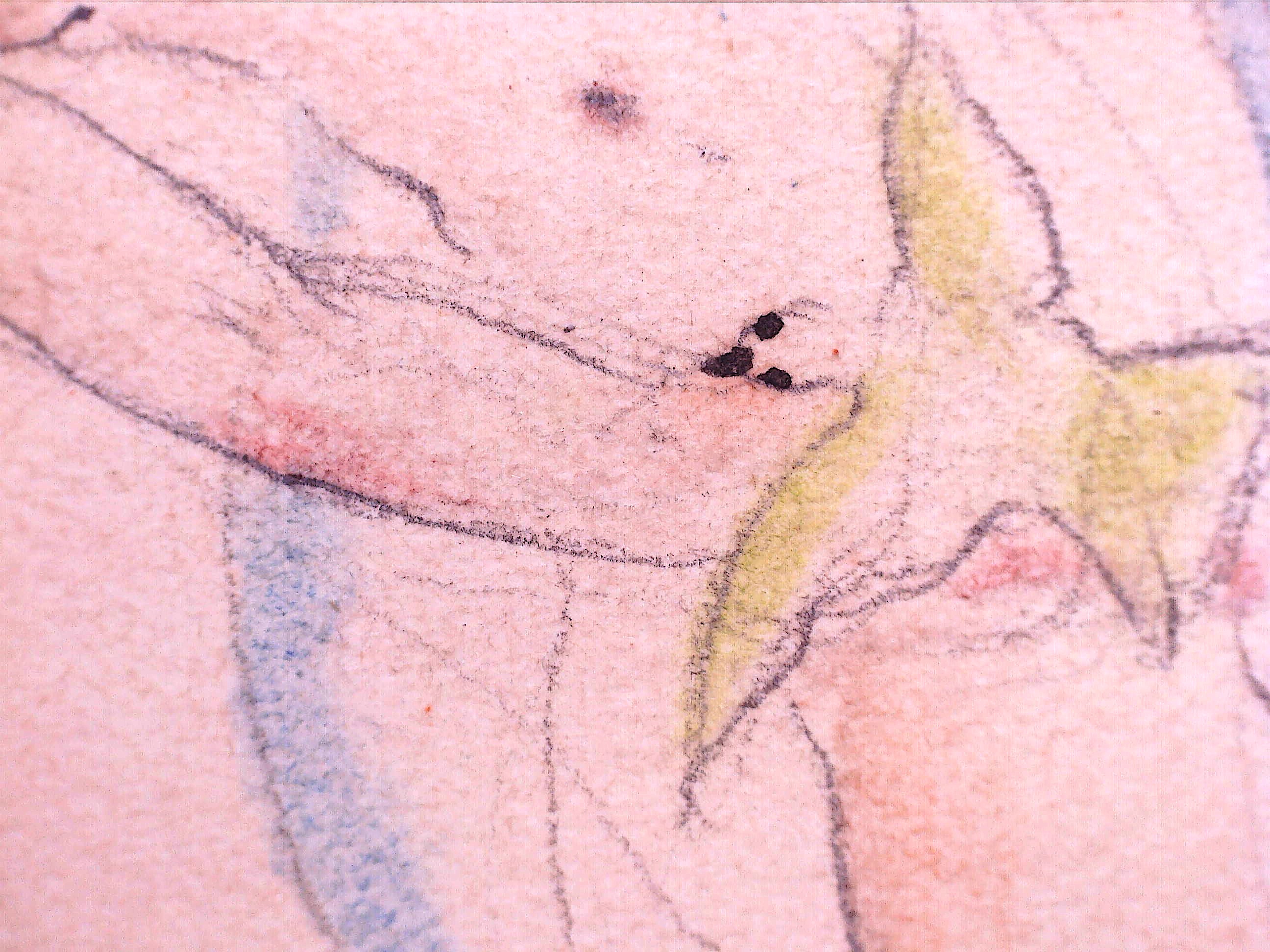
-
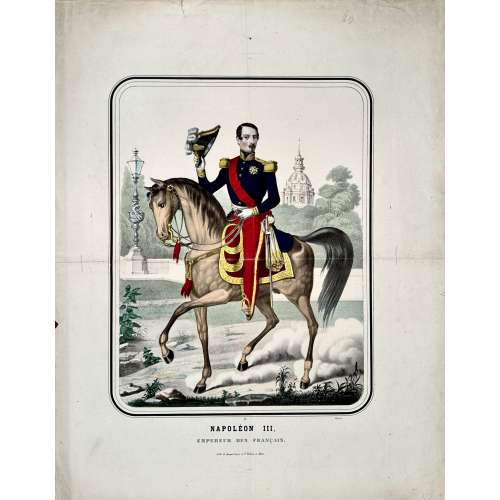 Hand-coloured chromolithography on wove paper, 600 x 470 mm; black ink stamp “4921” to reverse, horizontal and vertical centrefolds. Image of Napoléon III on horseback, in a frame; lettering under the frame: 34 — Déposé | NAPOLÉON III | EMPEREUR DES FRANÇAIS. | Lith. de Gangel frères et P. Didion, à Metz. || Gangel frères et P. Didion (Metz) – printer/publisher. Paulin Didion (French, 1831 – 1879)
Hand-coloured chromolithography on wove paper, 600 x 470 mm; black ink stamp “4921” to reverse, horizontal and vertical centrefolds. Image of Napoléon III on horseback, in a frame; lettering under the frame: 34 — Déposé | NAPOLÉON III | EMPEREUR DES FRANÇAIS. | Lith. de Gangel frères et P. Didion, à Metz. || Gangel frères et P. Didion (Metz) – printer/publisher. Paulin Didion (French, 1831 – 1879) -
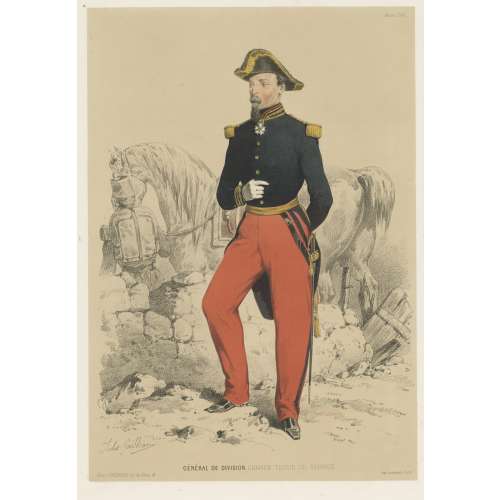 Chromolithography on thick wove paper, 473 x 315 mm sheet, 372 x 260 mm image, black ink stamp “5050” to reverse. Signed on stone "Jules Gaildrau"; below centre: "GÉNERAL DE DIVISION, GRANDE TENUE DE SERVICE"; Bottom left: "Paris, J. Gaildrau, rue de Seine, 16"; right: "Imp. Lemercier, Paris." Joseph Lemercier (French, 1803 – 1887) – printer. Jules Gaildrau (French, 1816 – 1898) – artist.
Chromolithography on thick wove paper, 473 x 315 mm sheet, 372 x 260 mm image, black ink stamp “5050” to reverse. Signed on stone "Jules Gaildrau"; below centre: "GÉNERAL DE DIVISION, GRANDE TENUE DE SERVICE"; Bottom left: "Paris, J. Gaildrau, rue de Seine, 16"; right: "Imp. Lemercier, Paris." Joseph Lemercier (French, 1803 – 1887) – printer. Jules Gaildrau (French, 1816 – 1898) – artist. -
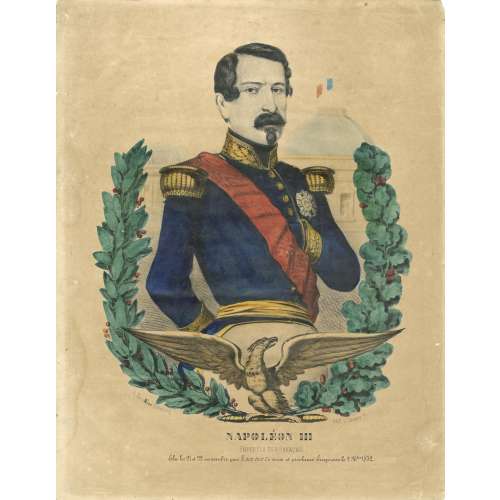 Hand-coloured lithography on wove paper, 380 x 298 mm; black ink stamp “4912” to reverse. On stone left: "A, Paris Miné Éditeur, imp.;" right: "Lith. R. St. Jacques. 41." Bottom center: "Napoléon III"; below: "EMPEREUR DES FRANÇAIS", under: "Élu les 21 el 22 novembre par 8,000,000 de voix et proclamé Empereur le 2 Xbre 1852." Printer/publisher: Miné, éditeur, imprimeur en lithographie, Rue Saint-Jacques, 41. Napoleon III [Charles-Louis Napoléon Bonaparte] (French, 1808 – 1873)
Hand-coloured lithography on wove paper, 380 x 298 mm; black ink stamp “4912” to reverse. On stone left: "A, Paris Miné Éditeur, imp.;" right: "Lith. R. St. Jacques. 41." Bottom center: "Napoléon III"; below: "EMPEREUR DES FRANÇAIS", under: "Élu les 21 el 22 novembre par 8,000,000 de voix et proclamé Empereur le 2 Xbre 1852." Printer/publisher: Miné, éditeur, imprimeur en lithographie, Rue Saint-Jacques, 41. Napoleon III [Charles-Louis Napoléon Bonaparte] (French, 1808 – 1873) -
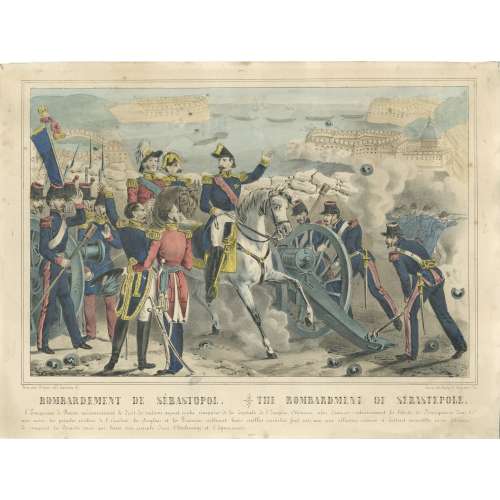 Hand-coloured lithography on wove paper, 250 x 332 mm; black ink stamp “5035” to reverse. Under the frame left: "Paris, chez Riboni, éd. r. Galande, 51"; right: "Paris, lith. Bulla, Pl. Maubert, 26". Below: "BOMBARDEMENT DE SEBASTOPOL. — THE BOMBARDMENT OF SÉBASTOPOLE". Text to bottom. Printers/publishers: Antoine Bulla (fl. 1815 – 1877), François Bulla (fl. c. 1814 – 1855).
Hand-coloured lithography on wove paper, 250 x 332 mm; black ink stamp “5035” to reverse. Under the frame left: "Paris, chez Riboni, éd. r. Galande, 51"; right: "Paris, lith. Bulla, Pl. Maubert, 26". Below: "BOMBARDEMENT DE SEBASTOPOL. — THE BOMBARDMENT OF SÉBASTOPOLE". Text to bottom. Printers/publishers: Antoine Bulla (fl. 1815 – 1877), François Bulla (fl. c. 1814 – 1855). -
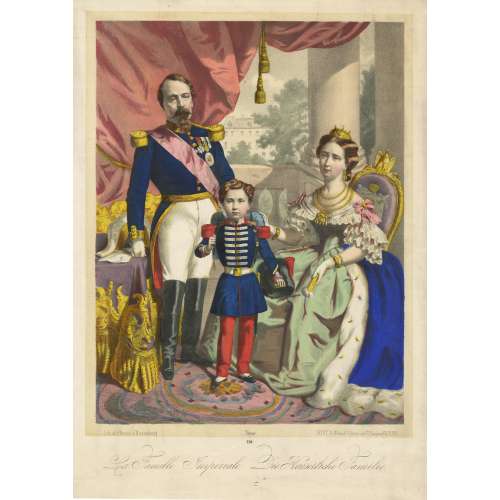 Hand-coloured lithography on wove paper, 395 x 280 mm; black ink stamp “5309” to reverse. On image: artist's initials "L. H."; on stone: "Lith. de Fr. Wentzel a Wissembourg. — Déposé — DÉPÔT, Fr. Wentzel Editeur rue St. Jacques 65, PARIS"; below centre: "239"; bottom : La famille Impériale. Die Kaizerliche Familie. Napoleon III [Charles-Louis Napoléon Bonaparte] (French, 1808 – 1873) Eugénie de Montijo [L'impératrice Eugénie] (Spanish-French, 1826 – 1920) Napoléon, Prince Imperial (Napoléon Eugène Louis Jean Joseph Bonaparte] (French, 1856 – 1879) Jean Frédéric Wentzel (French, 1807 – 1869) – publisher/printer.
Hand-coloured lithography on wove paper, 395 x 280 mm; black ink stamp “5309” to reverse. On image: artist's initials "L. H."; on stone: "Lith. de Fr. Wentzel a Wissembourg. — Déposé — DÉPÔT, Fr. Wentzel Editeur rue St. Jacques 65, PARIS"; below centre: "239"; bottom : La famille Impériale. Die Kaizerliche Familie. Napoleon III [Charles-Louis Napoléon Bonaparte] (French, 1808 – 1873) Eugénie de Montijo [L'impératrice Eugénie] (Spanish-French, 1826 – 1920) Napoléon, Prince Imperial (Napoléon Eugène Louis Jean Joseph Bonaparte] (French, 1856 – 1879) Jean Frédéric Wentzel (French, 1807 – 1869) – publisher/printer. -
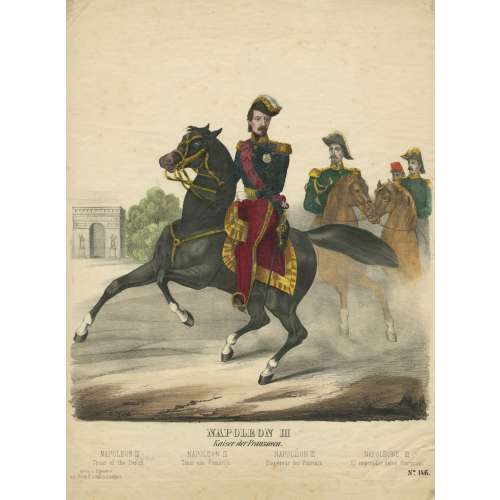 Hand-coloured lithography on wove paper 423 x 332 mm; On reverse: black ink stamp “4956”, ms “A”, ms pencil “428” and “Ernest”. Under the image, centre: "NAPOLEON III | Kaiser der Franzosen." Velow: | NAPOLEON III | Czaar of the French — NAPOLEON III | Czaar van Frankrijk — NAPOLÉON III | Empereur des Francais. — NAPOLEONE III | El emperador delos Franceses; bottom left: "Verlag u. Eigenthum | von. Fried. G. Schulz in Stuttgart.", right: "No 146." The artist's and printer's names in stone are not legible. Published in Stuttgart by Friederich Gustav Schulz (German, 1786 – 1859) during the time of the Second French Empire (1852-1870).
Hand-coloured lithography on wove paper 423 x 332 mm; On reverse: black ink stamp “4956”, ms “A”, ms pencil “428” and “Ernest”. Under the image, centre: "NAPOLEON III | Kaiser der Franzosen." Velow: | NAPOLEON III | Czaar of the French — NAPOLEON III | Czaar van Frankrijk — NAPOLÉON III | Empereur des Francais. — NAPOLEONE III | El emperador delos Franceses; bottom left: "Verlag u. Eigenthum | von. Fried. G. Schulz in Stuttgart.", right: "No 146." The artist's and printer's names in stone are not legible. Published in Stuttgart by Friederich Gustav Schulz (German, 1786 – 1859) during the time of the Second French Empire (1852-1870). -
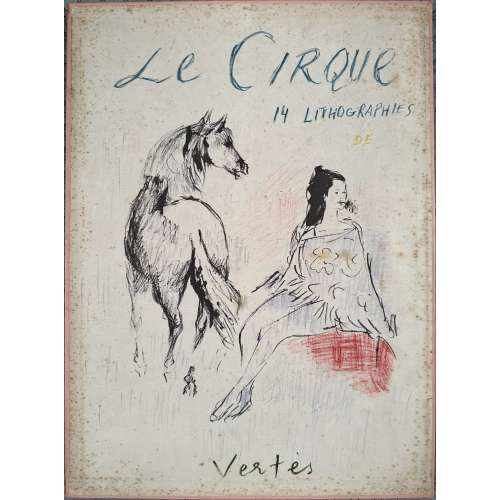 Publisher’s peach cloth box 555 x 410 mm with coloured lithograph on the lid, autographed with crayons "Le Cirque | 14 LITHOGRAPHIES | DE | {vignette} | Vertes"; in-folio unbound 4 pp. booklet on laid paper watermarked “Marais” and 14 loose leaves of plates on laid paper 520 x 395 mm without a watermark with coloured lithographs signed “Vertes” and numbered “195/250” in pencil; interleaved with tracing paper. Box and plates foxed. Title-page (red and black): LE | CIRQUE | 14 LITHOGRAPHIES DE | VERTÈS | PRÉSENTÉ | PAR | JEAN COCTEAU || Imprint: LES LIVES MERVEILLEUX | MONACO | Il a été tiré de cet album : | 150 Exemplaires, | destinés à | l'Amérique, | distribués bar les soins de | Arthur H. Harlow | de New-York, | & | 100 Exemplaires, | réservés à la France. | 15 Avril 1949 || Limitation: Edition limited to 250 copies (150 for USA, 100 for France); this is copy № 195 printed for France as the American copies marked “Published by Arthur H. Harlow & Co., New York. Seller’s Description: VERTÈS, Marcel (Hungarian-French, 1895-1961). Le Cirque 14 Lithographies de Vertès. Présénte par Jean Cocteau. [Monaco: Les Livres Merveilleux, 1949]. [vi] pp. With all 14 lithographs, each signed by the artist and numbered “195/250”. Text and lithographs 15 ¼ x 20 ½”. In original publisher’s peach cloth box with printed label on lid (box foxed, soiled, lightly worn; lithographs and text foxed). Still, a very good example of this lovely collection, with an introduction by Jean Cocteau (1889-1963). Catalogue Raisonné: Vokaer № 50. Marcel Vertès [Marcell Vértes] (Jewish-Hungarian-French, 1895 – 1961) – artist. Arthur H. Harlow (American, c. 1877 – 1958) – publisher. Jean Cocteau (French, 1889 – 1963) – author.
Publisher’s peach cloth box 555 x 410 mm with coloured lithograph on the lid, autographed with crayons "Le Cirque | 14 LITHOGRAPHIES | DE | {vignette} | Vertes"; in-folio unbound 4 pp. booklet on laid paper watermarked “Marais” and 14 loose leaves of plates on laid paper 520 x 395 mm without a watermark with coloured lithographs signed “Vertes” and numbered “195/250” in pencil; interleaved with tracing paper. Box and plates foxed. Title-page (red and black): LE | CIRQUE | 14 LITHOGRAPHIES DE | VERTÈS | PRÉSENTÉ | PAR | JEAN COCTEAU || Imprint: LES LIVES MERVEILLEUX | MONACO | Il a été tiré de cet album : | 150 Exemplaires, | destinés à | l'Amérique, | distribués bar les soins de | Arthur H. Harlow | de New-York, | & | 100 Exemplaires, | réservés à la France. | 15 Avril 1949 || Limitation: Edition limited to 250 copies (150 for USA, 100 for France); this is copy № 195 printed for France as the American copies marked “Published by Arthur H. Harlow & Co., New York. Seller’s Description: VERTÈS, Marcel (Hungarian-French, 1895-1961). Le Cirque 14 Lithographies de Vertès. Présénte par Jean Cocteau. [Monaco: Les Livres Merveilleux, 1949]. [vi] pp. With all 14 lithographs, each signed by the artist and numbered “195/250”. Text and lithographs 15 ¼ x 20 ½”. In original publisher’s peach cloth box with printed label on lid (box foxed, soiled, lightly worn; lithographs and text foxed). Still, a very good example of this lovely collection, with an introduction by Jean Cocteau (1889-1963). Catalogue Raisonné: Vokaer № 50. Marcel Vertès [Marcell Vértes] (Jewish-Hungarian-French, 1895 – 1961) – artist. Arthur H. Harlow (American, c. 1877 – 1958) – publisher. Jean Cocteau (French, 1889 – 1963) – author. -
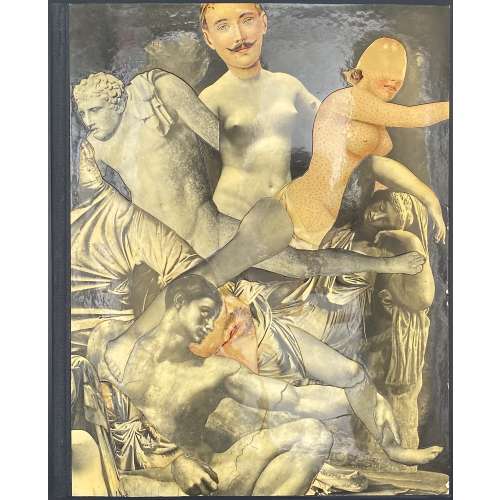 Hardcover volume, 25.2 x 20.5 cm, in a double slipcase 26.3 x 21.5 cm; black boards on cloth spine, front board with pasted photocollage in colour, first leaf thick verge paper different to the rest of the edition; top margin red, text printed on cream laid paper without a watermark and adorned with 14 in-text lithographs in black. A suite of 20 coloured lithographs 245 x 195 mm in the inner slipcase. Plates by Berthomme Saint-André. Pagination: [2] blanks, [3-8] 9-100 [101] blank, [2] colophon, limit. [2] blanks. Title-page (red and black): A. DE M. | GAMIANI | ou | deux nuits d'excès | Édition Réalisée | par les soins | et au profit exclusif des | « Vrais Amateurs Romantiques » | (Groupement de bibliophiles) || Limitation: № 1 – on Tonkin à la forme paper with two sets of plates, on Tonkin and one on Arches, printed in colour and in black, etc.; № 2 – similar but with the earlier state of one suite of plates; №№ 3-52 on Arches verge with plates on Tonkin; №№ 53-127 on Arches verge with plates on the same; №№ 128-227 on Rives with the suites on paper watermarked “Japon”; №№ 228-672 on Rives with the suites on the same; 25 copies marked A-Z of which A-J on Arches vergé and suites on Tonkin, and K-Z on Rives. Altogether 697 copies, of which this is copy № 27. Catalogue raisonné: Dutel III № 1650, p. 187-8; honesterotica.com. with a partially different set of in-text illustrations. Alfred de Musset (French, 1810 – 1857) – author. Louis Berthomme Saint-André (French, 1905 – 1977) – artist.
Hardcover volume, 25.2 x 20.5 cm, in a double slipcase 26.3 x 21.5 cm; black boards on cloth spine, front board with pasted photocollage in colour, first leaf thick verge paper different to the rest of the edition; top margin red, text printed on cream laid paper without a watermark and adorned with 14 in-text lithographs in black. A suite of 20 coloured lithographs 245 x 195 mm in the inner slipcase. Plates by Berthomme Saint-André. Pagination: [2] blanks, [3-8] 9-100 [101] blank, [2] colophon, limit. [2] blanks. Title-page (red and black): A. DE M. | GAMIANI | ou | deux nuits d'excès | Édition Réalisée | par les soins | et au profit exclusif des | « Vrais Amateurs Romantiques » | (Groupement de bibliophiles) || Limitation: № 1 – on Tonkin à la forme paper with two sets of plates, on Tonkin and one on Arches, printed in colour and in black, etc.; № 2 – similar but with the earlier state of one suite of plates; №№ 3-52 on Arches verge with plates on Tonkin; №№ 53-127 on Arches verge with plates on the same; №№ 128-227 on Rives with the suites on paper watermarked “Japon”; №№ 228-672 on Rives with the suites on the same; 25 copies marked A-Z of which A-J on Arches vergé and suites on Tonkin, and K-Z on Rives. Altogether 697 copies, of which this is copy № 27. Catalogue raisonné: Dutel III № 1650, p. 187-8; honesterotica.com. with a partially different set of in-text illustrations. Alfred de Musset (French, 1810 – 1857) – author. Louis Berthomme Saint-André (French, 1905 – 1977) – artist. -
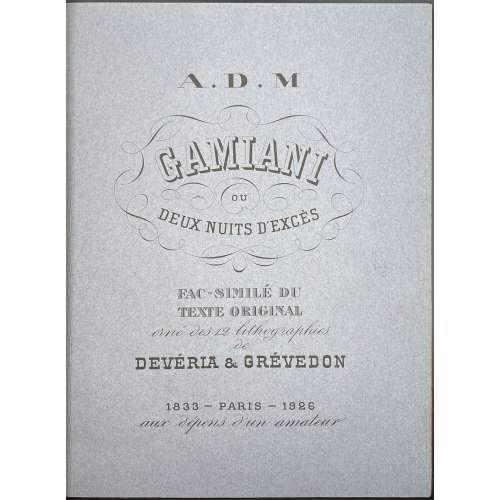 Description: ¾ contemporary red morocco over marbled boards, 33.1 x 25.8 cm, raised bands, gilt lettering to spine, in a marbled slipcase 34.2 x 25.9 cm. Printed on thick wove paper watermarked “MONTGOLFIER ANNONAY” by Canson & Montgolfier (Annonay, France). Front wrapper and title-page : A. D. M. | GAMIANI | OU | DEUX NUITS D’EXCÉS | FAC-SIMILE DU | TEXTE ORIGINAL | orné des 12 lithographies | de | DEVÉRIA & GRÉVEDON | 1833 – Paris – 1926 | aux dépens d'un amateur || Faux-t.p. (1): GAMIANI | OU | UNE NUIT D’EXCÉS | {vignette} | Bruxelles | 1833 || (fac-semilé of the original wrapper of 1833) Faux-t.p. (2): GAMIANI | OU | DEUX NUITS D’EXCÉS | {vignette} | Bruxelles | 1833 || (fac-semilé of the original wrapper of 1833) Collation: 2 blanks, 1 orig. lavender blue colour front wrapper, 1 blank, 1 h.t., 1 limitation p., 1 t.p., 3 leaves ‘Notice Bibliographique’, 32 leaves of printed text, 2 blanks, 1 brown faux t.p. (1), text in fac-semilé manuscript (7 leaves) with 8 coloured plates, 1 blank, 1 brown faux t.p. (2), 7 leaves of text with 4 plates, 2 blanks, brown back wrapper, lavender blue back wrapper, 2 blanks; total 64 leaves plus 16 plates. Pagination: [1-8] 9-75 [76] [4]; [1] 2-26; mispaginated p. 23 marked 25, f.t.p. and ffl not counted. Last four plates without letters. Limitation: a print run of 360 copies, of which 20 with ‘miniatures’ №№ 1-20, 100 with coloured plates №№ 21-120, 230 with b/w plates №№ 121-350; 10 copies not for sale, marked H. C. (hors commerce). This is copy № 201, which should be with black lithographs, but has coloured plates. According to J.-P. Dutel, the plates were printed from the original stones. For variations on Devéria & Grévedon designs for Gamiani see also: LIB-3087.2022 (Bruxelles, 1864); LIB-3093.2022 (Bruxelles, 1866); LIB-3090.2022 (Bruxelles, 1871); LIB-2902.2021 (Greman, 1911); LIB-2903.2021 (late 1940s). Catalogue raisonné: Dutel III 1640, p. 185. Contributors : Alfred de Musset (French, 1810 – 1857) – author. André Warnod [André de Sermanmagny] (French, 1885 – 1960) – author (bibliographical note) Pierre Louis Henri Grévedon (French, 1776 – 1860) – artist. Achille Devéria (French, 1800 – 1857) – artist.
Description: ¾ contemporary red morocco over marbled boards, 33.1 x 25.8 cm, raised bands, gilt lettering to spine, in a marbled slipcase 34.2 x 25.9 cm. Printed on thick wove paper watermarked “MONTGOLFIER ANNONAY” by Canson & Montgolfier (Annonay, France). Front wrapper and title-page : A. D. M. | GAMIANI | OU | DEUX NUITS D’EXCÉS | FAC-SIMILE DU | TEXTE ORIGINAL | orné des 12 lithographies | de | DEVÉRIA & GRÉVEDON | 1833 – Paris – 1926 | aux dépens d'un amateur || Faux-t.p. (1): GAMIANI | OU | UNE NUIT D’EXCÉS | {vignette} | Bruxelles | 1833 || (fac-semilé of the original wrapper of 1833) Faux-t.p. (2): GAMIANI | OU | DEUX NUITS D’EXCÉS | {vignette} | Bruxelles | 1833 || (fac-semilé of the original wrapper of 1833) Collation: 2 blanks, 1 orig. lavender blue colour front wrapper, 1 blank, 1 h.t., 1 limitation p., 1 t.p., 3 leaves ‘Notice Bibliographique’, 32 leaves of printed text, 2 blanks, 1 brown faux t.p. (1), text in fac-semilé manuscript (7 leaves) with 8 coloured plates, 1 blank, 1 brown faux t.p. (2), 7 leaves of text with 4 plates, 2 blanks, brown back wrapper, lavender blue back wrapper, 2 blanks; total 64 leaves plus 16 plates. Pagination: [1-8] 9-75 [76] [4]; [1] 2-26; mispaginated p. 23 marked 25, f.t.p. and ffl not counted. Last four plates without letters. Limitation: a print run of 360 copies, of which 20 with ‘miniatures’ №№ 1-20, 100 with coloured plates №№ 21-120, 230 with b/w plates №№ 121-350; 10 copies not for sale, marked H. C. (hors commerce). This is copy № 201, which should be with black lithographs, but has coloured plates. According to J.-P. Dutel, the plates were printed from the original stones. For variations on Devéria & Grévedon designs for Gamiani see also: LIB-3087.2022 (Bruxelles, 1864); LIB-3093.2022 (Bruxelles, 1866); LIB-3090.2022 (Bruxelles, 1871); LIB-2902.2021 (Greman, 1911); LIB-2903.2021 (late 1940s). Catalogue raisonné: Dutel III 1640, p. 185. Contributors : Alfred de Musset (French, 1810 – 1857) – author. André Warnod [André de Sermanmagny] (French, 1885 – 1960) – author (bibliographical note) Pierre Louis Henri Grévedon (French, 1776 – 1860) – artist. Achille Devéria (French, 1800 – 1857) – artist. -
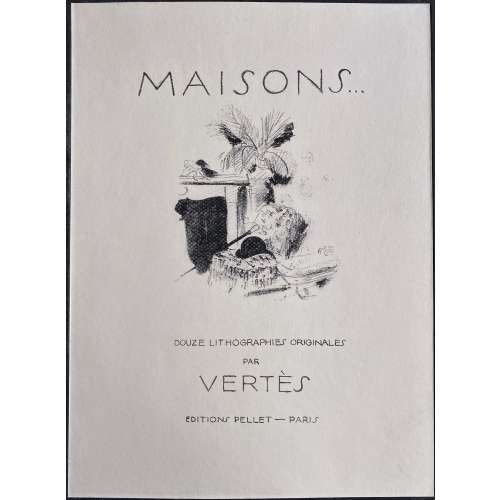 Album in-folio of 13 lithographs by Marcel Vertès, incl. title-page, each in a passe-partout 41.5 x 31.7 cm with 33.0 x 23.0 cm window, printed on wove paper sheets 38.0 x 28.0 cm and crayon-coloured by the artist; graphite pencil drawings by Marcel Vertès on the lower-right corner of each passe-partout; all in a buckram-backed flapped folder, signed ‘AT BOICHOT’, with an uncoloured title-page lithograph on front cover. Edition limited to 100 copies on Chine (№№ 1-100) and 900 on Vélin (№№ 1 to 900); this is a copy № 22 (Vélin), unique as enhanced by the artist. Double-folio leaf 41 x 31 cm with text by Pierre Mac-Orlan. These lithographs, uncoloured, were used in Pierre Mac-Orlan. Les jeux du demi-jour / avec douze lithographies de Vertès. — Paris: Les arts et le livre, 1926 [LIB-2893.2021]. Lithographed title-page: MAISONS.... | {vignette} | DOUZE LITHOGRAPHIES ORIGINALES | PAR | VERTÈS | ÉDITIONS PELLET ~ PARIS || Catalogue raisonné: Vokaer: № 5, p. 7; Nordmann (1): 423, p. 267. Contributors: Pierre Mac-Orlan (French, 1882 – 1970) – author. Marcel Vertès [Marcell Vértes] (Jewish-Hungarian-French, 1895 – 1961) – artist. Gustave Pellet (1859 – 1919) – publisher. Thomas Boichot – bookbinder. Description by J.-P. Dutel: MAC ORLAN Pierre. VERTES Marcel. MAISONS... Douze lithographies originales. Paris, Editions Pellet, [1925]. In-folio (410 x 310 mm) de [4] ff. et 13 lithographies sous passe-partout dont un titre. Chemise en demi-soienoire, premier plat illustré de la même lithographie que celle utilisée pour le titre (AT Boichot). TIRAGE : 100 albums sur chine avant la signature gravée, chaque planche signée. 900 albums sur vélin. :Un des 900 albums sur vélin (n° 22). EXEMPLAIRE UNIQUE DANS LEQUEL LES 13 LITHOGRAPHIES ONT ÉTÉCOLORIÉES AUX CRAYONS DE COULEURS PAR VERTÈS. DE PLUS, CHAQUE PASSE-PARTOUT COMPORTE EN BAS À DROITE UN CROQUIS ORIGINAL À LA MINE DE PLOMB CORRESPONDANT À UNE VERSION PLUS LIBRE DELA LITHO.
Album in-folio of 13 lithographs by Marcel Vertès, incl. title-page, each in a passe-partout 41.5 x 31.7 cm with 33.0 x 23.0 cm window, printed on wove paper sheets 38.0 x 28.0 cm and crayon-coloured by the artist; graphite pencil drawings by Marcel Vertès on the lower-right corner of each passe-partout; all in a buckram-backed flapped folder, signed ‘AT BOICHOT’, with an uncoloured title-page lithograph on front cover. Edition limited to 100 copies on Chine (№№ 1-100) and 900 on Vélin (№№ 1 to 900); this is a copy № 22 (Vélin), unique as enhanced by the artist. Double-folio leaf 41 x 31 cm with text by Pierre Mac-Orlan. These lithographs, uncoloured, were used in Pierre Mac-Orlan. Les jeux du demi-jour / avec douze lithographies de Vertès. — Paris: Les arts et le livre, 1926 [LIB-2893.2021]. Lithographed title-page: MAISONS.... | {vignette} | DOUZE LITHOGRAPHIES ORIGINALES | PAR | VERTÈS | ÉDITIONS PELLET ~ PARIS || Catalogue raisonné: Vokaer: № 5, p. 7; Nordmann (1): 423, p. 267. Contributors: Pierre Mac-Orlan (French, 1882 – 1970) – author. Marcel Vertès [Marcell Vértes] (Jewish-Hungarian-French, 1895 – 1961) – artist. Gustave Pellet (1859 – 1919) – publisher. Thomas Boichot – bookbinder. Description by J.-P. Dutel: MAC ORLAN Pierre. VERTES Marcel. MAISONS... Douze lithographies originales. Paris, Editions Pellet, [1925]. In-folio (410 x 310 mm) de [4] ff. et 13 lithographies sous passe-partout dont un titre. Chemise en demi-soienoire, premier plat illustré de la même lithographie que celle utilisée pour le titre (AT Boichot). TIRAGE : 100 albums sur chine avant la signature gravée, chaque planche signée. 900 albums sur vélin. :Un des 900 albums sur vélin (n° 22). EXEMPLAIRE UNIQUE DANS LEQUEL LES 13 LITHOGRAPHIES ONT ÉTÉCOLORIÉES AUX CRAYONS DE COULEURS PAR VERTÈS. DE PLUS, CHAQUE PASSE-PARTOUT COMPORTE EN BAS À DROITE UN CROQUIS ORIGINAL À LA MINE DE PLOMB CORRESPONDANT À UNE VERSION PLUS LIBRE DELA LITHO. -
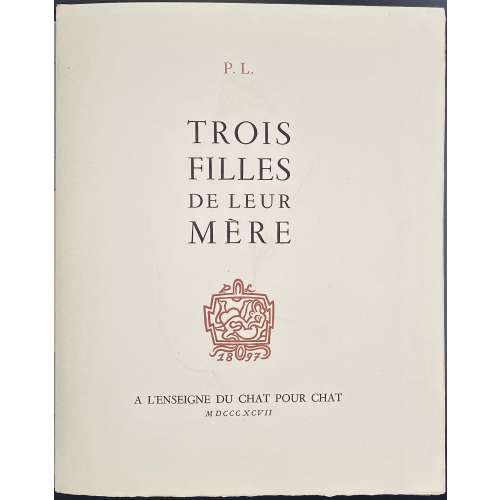 Description: Softcover, original blue-grey wrappers, maroon fleuron to front wrapper « P.L. {copulating couple} 1897. », 28.5 x 23 cm, in a grey double slipcase. Pp.: [1-10] 11-192 [2] [6 blanks], total 200 pages, 50 folio leaves folded in half collated in 4to, unbound, plus 16 coloured lithographs by Jean Berque; all printed on wove paper watermarked “LANA”. This is № 207 of an undisclosed number of copies. Edition enriched with a suite of 12 hand-coloured etchings after Éduard Chimot for publication in the late 1940s (Dutel 2524) on BFK Rives paper. Title-page (maroon and black): P. L. | TROIS | FILLES | DE LEUR | MÈRE | {fleuron} | A L'ENSEIGNE DU CHAT POUR CHAT | M DCCC XCVII || Catalogue raisonné: Dutel 2523, Pia 1340. Contributors: Pierre Louÿs (French, 1870 – 1925) – author. Jean Berque (French, 1896 – 1954) – artist. Édouard Chimot (French, 1880 – 1959) – artist.
Description: Softcover, original blue-grey wrappers, maroon fleuron to front wrapper « P.L. {copulating couple} 1897. », 28.5 x 23 cm, in a grey double slipcase. Pp.: [1-10] 11-192 [2] [6 blanks], total 200 pages, 50 folio leaves folded in half collated in 4to, unbound, plus 16 coloured lithographs by Jean Berque; all printed on wove paper watermarked “LANA”. This is № 207 of an undisclosed number of copies. Edition enriched with a suite of 12 hand-coloured etchings after Éduard Chimot for publication in the late 1940s (Dutel 2524) on BFK Rives paper. Title-page (maroon and black): P. L. | TROIS | FILLES | DE LEUR | MÈRE | {fleuron} | A L'ENSEIGNE DU CHAT POUR CHAT | M DCCC XCVII || Catalogue raisonné: Dutel 2523, Pia 1340. Contributors: Pierre Louÿs (French, 1870 – 1925) – author. Jean Berque (French, 1896 – 1954) – artist. Édouard Chimot (French, 1880 – 1959) – artist. -
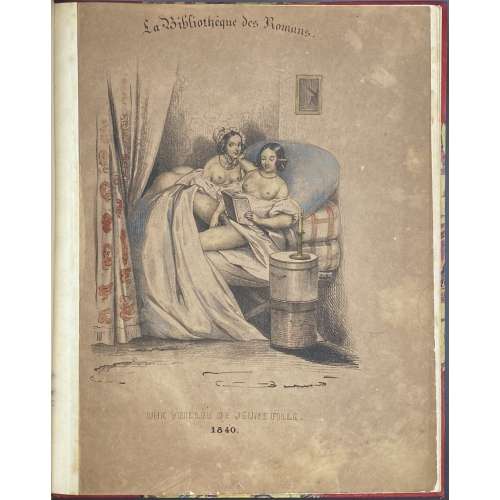 Description: Pictorial album 29.7 x 24 cm, bound in ¾ red morocco over marbled boards with gilt lettering “LA BIBLIOTHÈQUE DES ROMANS” and raised bands to spine; marbled endpapers, two flyleaves, tan original wrapper lettered “La Bibliothèque des Romans. (gothic, arch) | {colour vignette} | UNE VEILLÉE DE JEUNE FILLE. | 1840. || Six hand-coloured lithographs, each in a double-rule border with the series title above it and image title below. Sequential numbers are hand-inscribed within the border in the upper-right corner. Frame 23.5 x 18.3 cm, image 21.5 x 16.5 cm. Three flyleaves at the end. A bookplate to front pastedown: “GERARD NORDMANN EX-LIBRIS”. Content:
Description: Pictorial album 29.7 x 24 cm, bound in ¾ red morocco over marbled boards with gilt lettering “LA BIBLIOTHÈQUE DES ROMANS” and raised bands to spine; marbled endpapers, two flyleaves, tan original wrapper lettered “La Bibliothèque des Romans. (gothic, arch) | {colour vignette} | UNE VEILLÉE DE JEUNE FILLE. | 1840. || Six hand-coloured lithographs, each in a double-rule border with the series title above it and image title below. Sequential numbers are hand-inscribed within the border in the upper-right corner. Frame 23.5 x 18.3 cm, image 21.5 x 16.5 cm. Three flyleaves at the end. A bookplate to front pastedown: “GERARD NORDMANN EX-LIBRIS”. Content:- Front wrapper (title-page)
- SŒUR ANNE (Sister Anne)
- LA GRISETTE (The grisette)
- LÉONIDE OU LA VIEILLE DE SURÊNE (Léonide or the old lady of Surêne)
- LA PUCELLE DE BELLEVILLE (The maid of Belleville)
- MON VOISIN RAYMOND (My neighbor Raymond)
- LE COCU (The cuckold)
-
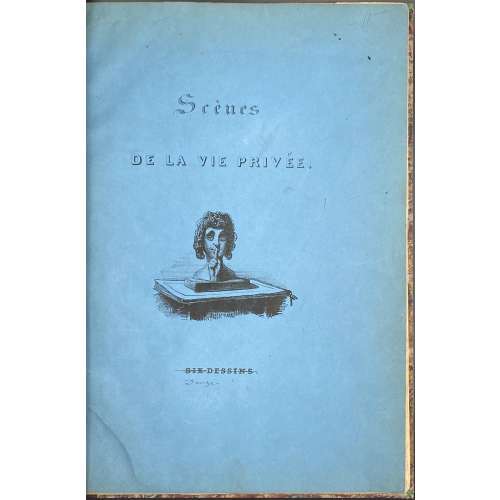 Pictorial album 31 x 22.8 cm, bound in quarter red calf over marbled boards with gilt lettering “SCÈNES | DE | LA VIE | PRIVÉE” and gilt ornament to spine; marbled endpapers, flyleaf, blue original wrapper (title-page) lettered SCÈNES | DE LA VIE PRIVÉE. | {vignette} | SIX DESSINS || «Six dessins» struck out, ms inscription beneath “Douze”. Twelve hand-coloured lithographs, some inscribed with letters and/or numbers in reverse, each in a double-rule frame 22 x 16.5 cm, images 18 x 14.5 cm (approx.); series title “Scènes de la vie intime” printed above the frame, image title printed in the lower compartment; ms numbers above the upper-right corner of the frame (state before sequential numbers, ms numbers do not correspond with artist numbering). Flyleaf at the end. Two bookplates to front pastedown: “EX-LIBRIS PAUL GAVAULT” and armorial “IN ROBORE ROBUR | Ex Libris Bourlon de Rouvre”. Content (Roman numerals in parenthesis are publisher's numbers; numerals in italic are Armelhault-Bocher reference numbers):
Pictorial album 31 x 22.8 cm, bound in quarter red calf over marbled boards with gilt lettering “SCÈNES | DE | LA VIE | PRIVÉE” and gilt ornament to spine; marbled endpapers, flyleaf, blue original wrapper (title-page) lettered SCÈNES | DE LA VIE PRIVÉE. | {vignette} | SIX DESSINS || «Six dessins» struck out, ms inscription beneath “Douze”. Twelve hand-coloured lithographs, some inscribed with letters and/or numbers in reverse, each in a double-rule frame 22 x 16.5 cm, images 18 x 14.5 cm (approx.); series title “Scènes de la vie intime” printed above the frame, image title printed in the lower compartment; ms numbers above the upper-right corner of the frame (state before sequential numbers, ms numbers do not correspond with artist numbering). Flyleaf at the end. Two bookplates to front pastedown: “EX-LIBRIS PAUL GAVAULT” and armorial “IN ROBORE ROBUR | Ex Libris Bourlon de Rouvre”. Content (Roman numerals in parenthesis are publisher's numbers; numerals in italic are Armelhault-Bocher reference numbers):- Titre de la couverture (Title-page) – 2001
- (III) Un nid dans les blés (A nest in the wheat) – 2004
- (II) Amitié de pension (Friendship in the pension) – 2003
- (XI) Bras dessus, bras dessous (Arm up, arm down) – 2012
- (I) Causerie (Chat) – 2002
- (VI) Prélude (Prelude) – 2007
- (IX) Le guet-apens (Ambush) – 2010
- (V) Le cabinet noir (The dark chamber) – 2006
- (IV) Distraction (Entertainment) – 2005
- (X) Leçon de paysage (Landscape lesson) – 2011
- (VII) Avant le péché (Before sin) – 2008
- (VIII) Après le péché (After sin) – 2009
- (XII) La femme du peintre (The painter's wife) – 2013
-
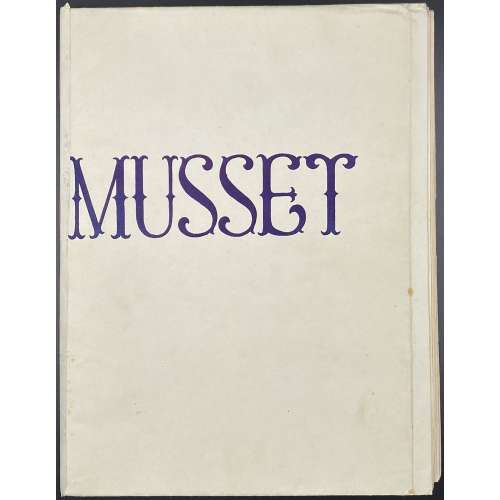 Description: one volume in French flapped wrappers 25.3 x 19 cm, lettered “MUSSET” to front, 5 gatherings of 4 and one of 6 leaves, 26 leaves total, pp.: [4] [2] 3-43 [44] [4], total 52 pages, incl. those in wrappers, unbound; plus coloured and uncoloured suites of 12 lithographs, in a paper folder; in a cardboard tan slipcase 2.8 x 19.3 cm. Artist unknown, publisher unknown, published at the end of 1940s (per J.-P. Dutel). Illustrations are a loose interpretation of original lithographs by Devéria and Henri Grévedon or Octave Tassaert for the 1833 edition ((1926 re-print LIB-3135.2023). Limitation: Edition limited to 250 copies printed on Vélin Chiffon numbered 1 -250 and 24 copies marked by letters A to Z. This is copy № 246, with two suites of plates, one coloured and one b/w. Catalogue raisonné: Dutel (1920-1970) № 1657, p. 189. Alfred de Musset (French, 1810 – 1857) – author.
Description: one volume in French flapped wrappers 25.3 x 19 cm, lettered “MUSSET” to front, 5 gatherings of 4 and one of 6 leaves, 26 leaves total, pp.: [4] [2] 3-43 [44] [4], total 52 pages, incl. those in wrappers, unbound; plus coloured and uncoloured suites of 12 lithographs, in a paper folder; in a cardboard tan slipcase 2.8 x 19.3 cm. Artist unknown, publisher unknown, published at the end of 1940s (per J.-P. Dutel). Illustrations are a loose interpretation of original lithographs by Devéria and Henri Grévedon or Octave Tassaert for the 1833 edition ((1926 re-print LIB-3135.2023). Limitation: Edition limited to 250 copies printed on Vélin Chiffon numbered 1 -250 and 24 copies marked by letters A to Z. This is copy № 246, with two suites of plates, one coloured and one b/w. Catalogue raisonné: Dutel (1920-1970) № 1657, p. 189. Alfred de Musset (French, 1810 – 1857) – author. -
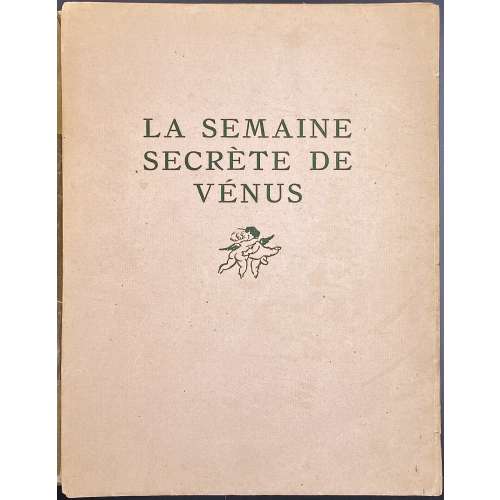 Description: Publisher’s tan French flapped wrappers, in glassine DJ, 25.4 x 19.4 cm, collated in-4to, lettered LA SEMAINE | SECRÈTE DE | VÉNUS | {fleuron} ||, outer margin uncut. Title-page: ≈ | LA SEMAINE | SECRÈTE | DE VÉNUS | Illustrée de huit Dessins | originaux reproduits en | lithographie et coloriés | {vignette} | LA CHRONIQUE CLANDESTINE | ≈ de 1919 à 1925 ≈ || Limitation: Unique copy on Vieux Japon enriched with original drawings and suites of plates, № 1-25 on Japon Imperial, enriched with 1 drawing and 3 suites of plates, № 26-275 on vélin d’Arches «avec les sept lithos en couleurs»; total print run – 275+1. This is copy № 70. Collation: π3 (blank, h.t./limit., t.p.), 1-154 χ1, total 64 leaves plus 7 plates, lithographs after drawings by Marcel Vertès, extraneous to collation. Note: Eight lithographs stated in the title are 7 plates AND a vignette on the title page. Vokaer attributes the printer/publisher as "Imprimerie Daragnès" and the year of publication as 1925. Pagination: [6] 2 blanks, 2 h.t. / limit., 2 t.p., [1-2] 3-115 [7] ; total 128 pages plus ils. Catalogue raisonné: Dutel (1920-1970): № 2386; Pia (Enfer) 1317; Nordmann (1): 246; Vokaer (1967): 8, Contributors : Pierre Mac-Orlan (French, 1882 – 1970) – author. Marcel Vertès [Marcell Vértes] (Jewish-Hungarian-French, 1895 – 1961) – artist. Paul Cotinaud – publisher (per Dutel) Coulouma (Argenteuil) – printer (per Dutel).
Description: Publisher’s tan French flapped wrappers, in glassine DJ, 25.4 x 19.4 cm, collated in-4to, lettered LA SEMAINE | SECRÈTE DE | VÉNUS | {fleuron} ||, outer margin uncut. Title-page: ≈ | LA SEMAINE | SECRÈTE | DE VÉNUS | Illustrée de huit Dessins | originaux reproduits en | lithographie et coloriés | {vignette} | LA CHRONIQUE CLANDESTINE | ≈ de 1919 à 1925 ≈ || Limitation: Unique copy on Vieux Japon enriched with original drawings and suites of plates, № 1-25 on Japon Imperial, enriched with 1 drawing and 3 suites of plates, № 26-275 on vélin d’Arches «avec les sept lithos en couleurs»; total print run – 275+1. This is copy № 70. Collation: π3 (blank, h.t./limit., t.p.), 1-154 χ1, total 64 leaves plus 7 plates, lithographs after drawings by Marcel Vertès, extraneous to collation. Note: Eight lithographs stated in the title are 7 plates AND a vignette on the title page. Vokaer attributes the printer/publisher as "Imprimerie Daragnès" and the year of publication as 1925. Pagination: [6] 2 blanks, 2 h.t. / limit., 2 t.p., [1-2] 3-115 [7] ; total 128 pages plus ils. Catalogue raisonné: Dutel (1920-1970): № 2386; Pia (Enfer) 1317; Nordmann (1): 246; Vokaer (1967): 8, Contributors : Pierre Mac-Orlan (French, 1882 – 1970) – author. Marcel Vertès [Marcell Vértes] (Jewish-Hungarian-French, 1895 – 1961) – artist. Paul Cotinaud – publisher (per Dutel) Coulouma (Argenteuil) – printer (per Dutel). -
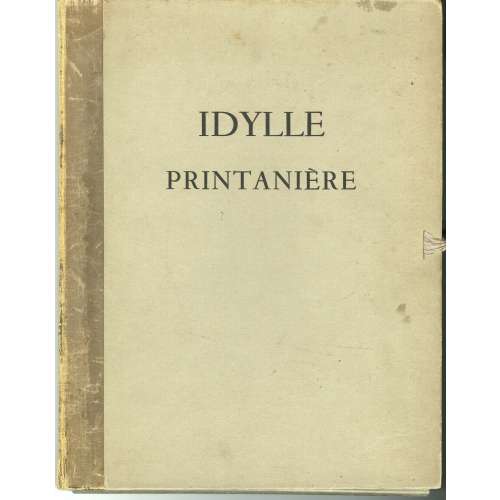 Title: IDYLLE | PRINTANIÈRE || Verso: {Headpiece} | Justification du tirage | {7 lines of text} | Exemplaire № 56 (digits by hand) | HP (monogram by hand) | {tailpiece} || Album of 30 hand-coloured lithographs and frontispiece in a cardboard folder; each sheet mounted in a 32.5 x 25 cm passepartout with 19 x 13 cm window; published in Paris in 1938 by Henri Pasquinelli (attributed). No artist, no publisher name indicated. According to Justification du tirage, the print run of 516 copies on Arches laid tinted paper (vergé), copy A – control artist’s uncoloured, 15 copies B–P reserved for collaborators and friends, copies 1–500 – for bibliophiles. This copy № 56, autographed by the publisher's monogram: "HP". Catalogue Raisonné: J.-P. Dutel, vol 2 (1920–1970), #1726, p. 207-8. Provenance: J.-P. Dutel.
Title: IDYLLE | PRINTANIÈRE || Verso: {Headpiece} | Justification du tirage | {7 lines of text} | Exemplaire № 56 (digits by hand) | HP (monogram by hand) | {tailpiece} || Album of 30 hand-coloured lithographs and frontispiece in a cardboard folder; each sheet mounted in a 32.5 x 25 cm passepartout with 19 x 13 cm window; published in Paris in 1938 by Henri Pasquinelli (attributed). No artist, no publisher name indicated. According to Justification du tirage, the print run of 516 copies on Arches laid tinted paper (vergé), copy A – control artist’s uncoloured, 15 copies B–P reserved for collaborators and friends, copies 1–500 – for bibliophiles. This copy № 56, autographed by the publisher's monogram: "HP". Catalogue Raisonné: J.-P. Dutel, vol 2 (1920–1970), #1726, p. 207-8. Provenance: J.-P. Dutel.


